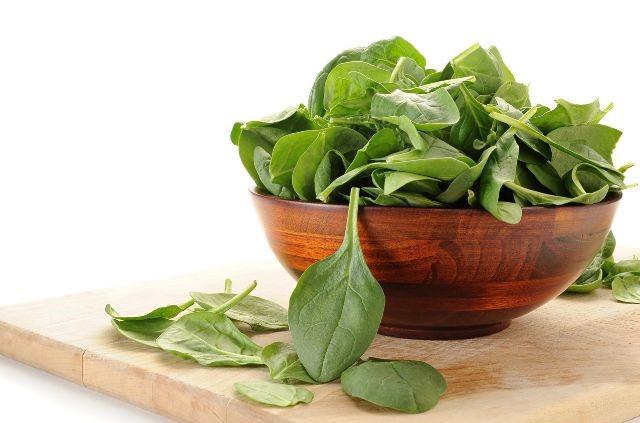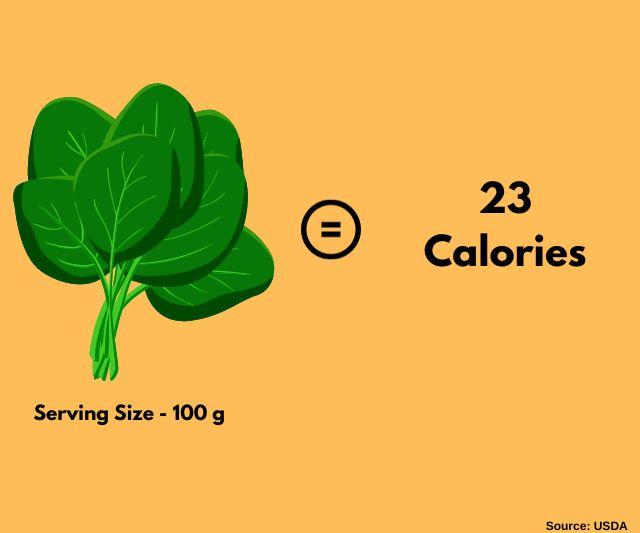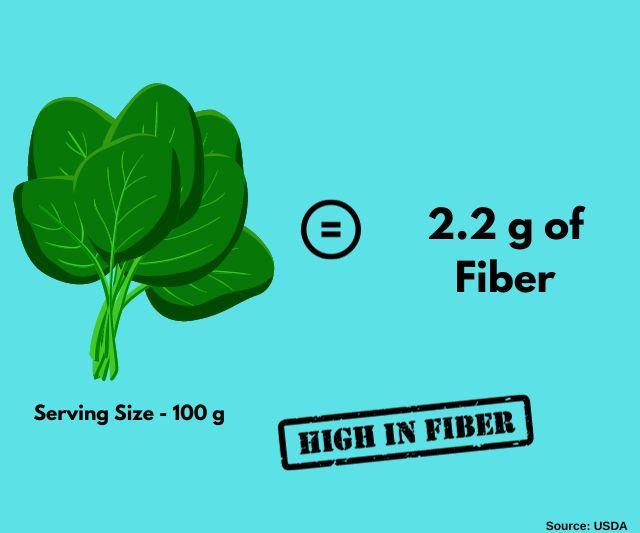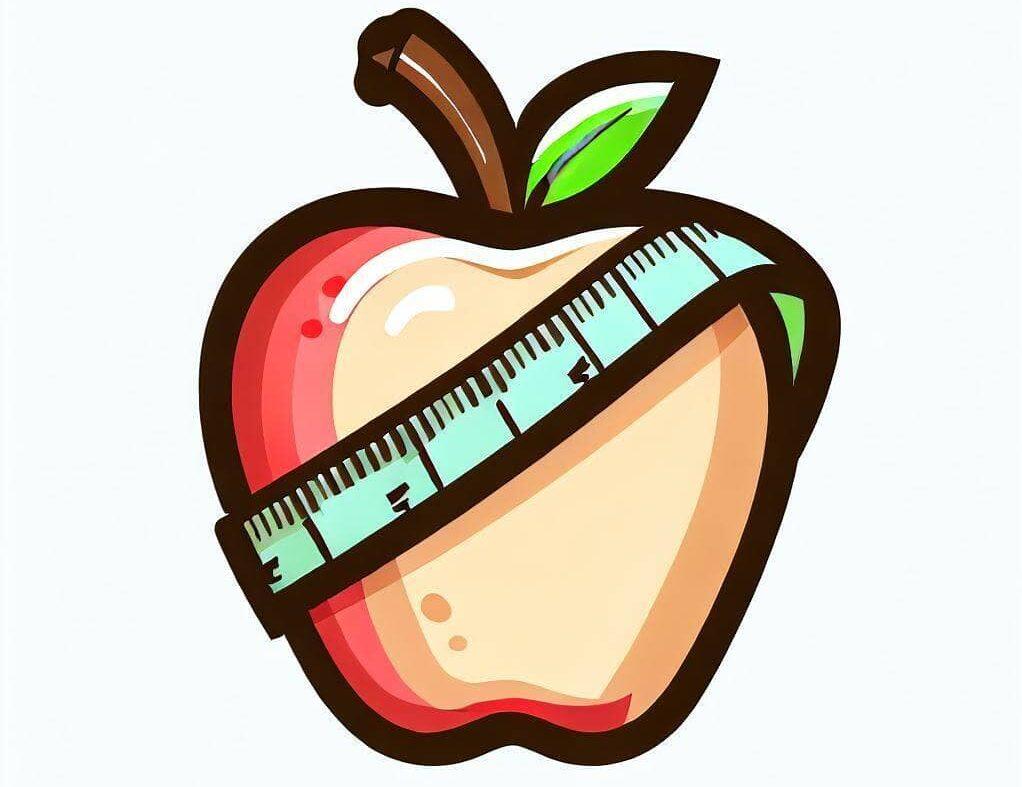Is Spinach Good For Weight Loss?
This post may contain affiliate links which means I may receive a commission for purchases made through links at no extra cost to you. See my disclosure policy for more information.

Spinach is good for weight loss because a) it is low in calories and b) it is high in fiber.
Both these properties are pro-weight loss. Meaning it can help you lose weight.
If you are anything like my clients, vegetables like spinach or lettuce must be a daily part of your meals.
And you want to make sure that they dont hinder your weight loss goals.
But how do these properties in spinach help you lose weight? Let’s find out.
Nutritional Value Of Spinach
As per the USDA, 3.5 ounces (100 grams) of raw spinach contains the following nutrients:
Serving Size: 100 g
- Calories: 23
- Protein: 2.9 g
- Carbs: 3.6 g
- Sugar: 0.4 g
- Fiber: 2.2 g
- Fat: 0.4 g
Potential Benefits Of Spinach
Low in Calories

Spinach only has 23 calories per 100 g. This is particularly good for weight loss because then you don’t have to worry about calorie counting with spinach.
When you’re trying to lose weight, you need to eat fewer calories than your body uses.
Spinach helps with this because you can fill up on it without going over your calorie limit.
It’s like eating a big plate of food but not getting too many calories from it. This way, you don’t feel hungry all the time when you’re dieting.
Eating fewer calories makes your body start using the fat it has stored for energy, which helps you lose weight.
So, because spinach has so few calories, it’s a good choice for losing weight.
High in Fiber

The fiber in spinach helps you feel full because of how it works in your stomach and how it talks to your brain.
When you eat spinach, the fiber in it soaks up water and gets bigger in your stomach.
This makes your stomach feel full because it takes up space. Your stomach has special sensors that notice when it’s stretched out by this fiber.
These sensors tell your brain, “Hey, I’m full!” Also, fiber moves slowly through your stomach and intestines, which means it takes longer for your body to digest it.
This slow digestion keeps you feeling full for a longer time.
Plus, it helps keep your blood sugar level steady, so you don’t get sudden hunger pangs.
All this helps you not to eat too much, which is good if you’re trying to watch your weight.
Also Read: Is Chocolate Milk Good For Weight Loss?
Downsides of Spinach for Weight Loss
Taste Fatigue with Spinach

When you eat the same food repeatedly, your sensory response to that food (taste, smell, texture) diminishes.
This is because your brain’s reward centers become less responsive to the flavors and textures of that food over time.
It’s a natural mechanism to encourage dietary variety, which is essential for obtaining a wide range of nutrients.
The monotony of eating the same food, like spinach, can lead to boredom with your diet.
This psychological response can diminish your overall satisfaction with meals, leading to a decreased interest in healthy eating and an increased desire for more varied and often less healthy options.
This is because the brain seeks novel experiences and flavors as a form of psychological reward.
Over time, your taste receptors and brain can adapt to the repeated stimulus of the same food, reducing the pleasure you derive from it.
This adaptation can lead to seeking out more intensely flavored or varied foods to achieve the same level of satisfaction, which can often be foods that are less conducive to weight loss.
Health Halo Effect of Spinach

Sometimes, because you know spinach is good for you, you might think that any food with spinach in it is also really healthy.
This idea can make you eat too much of foods like spinach pies or creamy spinach dips, which actually have a lot of calories, fat, or sugar.
The spinach in them makes you think they’re better for you than they really are.
Because of this, you might end up eating more of something just because it has spinach. Like, you might have a big piece of a spinach quiche thinking it’s totally healthy.
But actually, you’re getting more calories than you think, because of the other stuff in it like cheese or pastry, not just the spinach.
When there’s spinach in your food, you might not pay as much attention to how much of the other stuff you’re eating.
So, even though you’re eating spinach, you might still end up eating more calories than you planned, because of things like cheese or sauce in the dish.
It’s important to remember that just because there’s spinach in a dish, it doesn’t mean everything else in it is good for losing weight.
You should think about all the things in your meal, not just the spinach. This way, you get a better idea of how healthy your whole meal is, not just because it has spinach.
Tips For Incorporating Spinach Into a Weight Loss Diet
Use it in Salads
Using spinach as a base for salads is a fantastic way to create a nutrient-dense meal. Spinach offers more nutritional value than many other salad greens, being rich in vitamins, minerals, and fiber.
When you mix spinach with other vegetables, you add variety and additional nutrients.
Adding lean proteins like grilled chicken or tofu can turn the salad into a complete meal, providing essential proteins while still keeping it low in calories.
Using a light dressing ensures you don’t add unnecessary fats or sugars.
Eating a spinach salad for lunch or dinner is not only satisfying but also helps prevent overeating. The high fiber content of spinach makes you feel full, reducing the likelihood of snacking later.
Add to Morning Smoothies
Incorporating spinach into your morning smoothie is an effortless way to kickstart your day with essential nutrients.
Spinach blends well with fruits and other ingredients without overpowering the taste.
It adds fiber and vitamins while being easy on the stomach, making it a great option for those who prefer a light but nourishing breakfast.
This kind of smoothie can keep you full and energized throughout the morning, helping to curb mid-morning hunger and the temptation to snack on less healthy options.
Also Read: Is Crystal Light Good For Weight Loss?
Include in Omelets or Scrambles for Breakfast
Adding spinach to your breakfast omelets or scrambled eggs is a great way to enhance your first meal of the day.
The morning is an ideal time to consume nutrient-rich foods, and spinach provides vitamins and minerals that offer sustained energy, helping you stay full and focused until your next meal.
This can be particularly helpful in preventing unhealthy snacking before lunch.
Also Read: Is Egg Salad Good For Weight Loss?
Use in Wraps and Sandwiches for Lunch
Incorporating spinach into wraps and sandwiches is a smart choice for a midday meal. It’s a light addition that adds volume and nutrients without contributing many calories.
This can help you avoid the heavy, sluggish feeling that often comes after eating a big, calorie-dense lunch.
The fiber in the spinach keeps you feeling full, which can help you stay productive and energized throughout the afternoon.
Blend into Soups and Stews for a Light Dinner
Adding spinach to soups and stews is an excellent way to create a dinner that’s both light and nutritious.
Consuming a lighter meal in the evening can be beneficial for digestion and may improve sleep quality.
Spinach wilts down in the cooking process, so it can be easily added to various recipes without altering the overall flavor of the dish too much.
This makes it a versatile ingredient for dinner meals, adding nutrients without adding heaviness.
Also Read: Is Watermelon Good For Weight Loss?
Alternatives to Spinach For Weight Loss
Arugula
When you’re on a weight loss journey, the peppery zing of arugula can be a game-changer.
Unlike the mild taste of spinach, arugula’s bold flavor profile can make a simple salad feel gourmet, which may help satisfy your palate with smaller portions.
It’s a strategic choice for those seeking to reduce calorie intake without sacrificing taste.
The pungent taste of arugula also stimulates the taste buds and digestion, potentially aiding in a more effective metabolism.
Butterhead Lettuce
Butterhead lettuce, with its tender leaves, is a great spinach substitute for those who prefer a milder taste.
It’s perfect for creating bulk meals, which means you can have a large, satisfying portion on your plate without adding many calories—a crucial element in maintaining a calorie deficit for weight loss.
Its soft texture blends seamlessly into wraps and sandwiches, offering a satisfying mouthfeel without the calorie load of heavier ingredients.
Watercress
Watercress is not just a garnish; it’s a nutrient-rich, low-calorie food that provides a satisfying crunch and spicy flavor to meals.
This can help keep your taste buds engaged, making you less likely to seek out high-calorie foods for flavor.
The act of chewing the slightly tougher leaves more than softer greens like spinach can also contribute to feeling fuller, and faster.
This can be particularly beneficial for those who are prone to mindless eating, as it encourages slower, more mindful consumption.
Kale
Incorporating kale into your weight loss diet can offer a textural change that requires more chewing, which is beneficial for controlling hunger.
Kale’s hearty texture not only keeps you feeling full but also takes longer to eat, giving your body time to register satiety signals. This can prevent overeating during meals.
Additionally, kale’s robust nature allows it to be used in a variety of cooking methods, from baking to sautéing, providing culinary diversity that can make sticking to a weight loss regimen more enjoyable.
Swiss Chard
Swiss chard can play a significant role in a weight loss diet for those who enjoy cooked vegetables. Its ability to maintain volume when cooked means that it can make meals feel more substantial and filling.
For someone reducing their calorie intake, a sizable helping of Swiss chard can add the necessary bulk to meals that make them satisfying, while still being low in calories.
This can be especially valuable for dinner, where a fulfilling meal can prevent late-night snacking.
Also Read: Is Pasta Salad Good For Weight Loss?
Conclusion
Spinach is a great choice for weight loss because it’s low in calories and doesn’t have any high amounts of nutrients that could slow down your progress.
However, to really succeed in losing weight, it’s important to have a balanced diet. That means you should also eat a variety of other foods that are low in calories but rich in nutrients.
Don’t forget to stay active, get plenty of sleep, and keep your stress levels in check.
Remember, no single food will make you lose weight on its own. It’s your overall lifestyle that makes the biggest difference.
FAQ
How to Eat Spinach for Weight Loss?
Include spinach in salads, smoothies, omelets, and soups. Use it as a low-calorie, nutrient-rich ingredient to add volume and fiber to your meals without adding many calories.
Does Spinach Help You Lose Weight?
Yes, spinach can help with weight loss. It’s low in calories and high in fiber, which can make you feel full and satisfied, helping to reduce overall calorie intake.
Does Spinach Help Weight Loss?
Yes, spinach supports weight loss. Its high fiber content aids in feeling full, and being low in calories, it can be consumed in larger volumes without contributing significantly to daily calorie limits.
Does Spinach Burn Fat?
No, spinach itself does not directly burn fat. However, it can support weight loss efforts due to its low-calorie count and high fiber content, which can help you feel full and reduce overall calorie intake, indirectly aiding in fat loss.
This post may contain affiliate links which means I may receive a commission for purchases made through links at no extra cost to you. See my disclosure policy for more information.
Rahul is a professional nutritionist certified by the International Sports Sciences Association (ISSA) and a personal trainer certified through the American Council of Exercise (ACE). He has a special interest in the science of nutrition and how it can impact the body.
